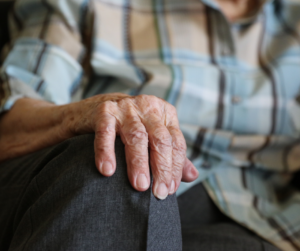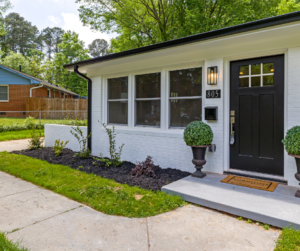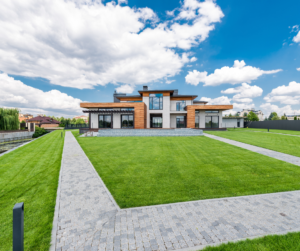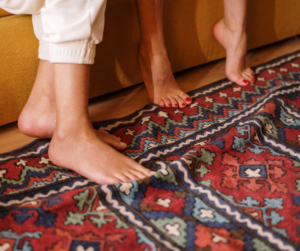Written by: Olivia Forgette
The term “aging in place” is one that older individuals may be familiar with. The phrase refers to the notion that there is a preference to age gracefully in your current home for as long as possible. According to a 2014 survey administered by AARP, 88-percent of those aged 65 years and older agreed they would prefer to stay in their current home as they age, rather than downsizing or moving into an assisted living facility.

Aging in place is clearly desired, but why? Can it be because a home is where memories are held? Or could it be because a home can help keep connections with friends and family easier? Whatever your reason for wanting to age in place, we have you covered with our top seven ways to prepare your home for aging in place.
1) Stair-ing problem
Stairs are a major concern when it comes to aging in place. Stair climbing is a huge challenge for elderly individuals, with nearly 40-percent of adults over the age of 80 reporting stairs are a challenge or risk for them. About half of all homes in the United States are equipped with stairs in some form. In fact, research has found that there is a stair related injury in the United States about 3,000 times per day, or about one injury every 30 seconds.

Understanding this risk will help you age in place by finding a solution. There are numerous solutions to stairs and making them more accessible as we age. Our top option to help prepare your home for aging in place regarding stairs is to install a stair lift. There are different varieties of these products to help fit your space and needs including outdoor versions, straight, and curved lifts.
Cost for stair lifts vary based on the size of your staircase and type of lift you require. Know that you can opt to rent a stair lift for a lower upfront cost.
Another option to eliminate the worry of stairs is to install a residential elevator. This is an expensive option, but an option nonetheless.
2) First floor living
If risking the stairs doesn’t sound like your cup of tea, you may want to consider moving your bedroom to the first floor. This would create a space with your primary needs being met on one single level of your home.

If you feel like your home can accommodate a first floor main bedroom, this can be a great, less invasive option for seniors looking to age in place. Something to consider with this choice is that you will still be paying utilities and taxes for the additional unused square footage, which can be wasteful.
3) Modify your bathroom

Another major concern as we age is a slip-and-fall in the bathroom. Surfaces are often wet and slick in a bathroom, making it a high risk area for seniors aging in place. We suggest installing mobility aids throughout your bathroom. This includes shower and bathtub grab bars, bathtub and shower seats, and raised toilet seats. If you’re willing to make the remodel, it’s also a good idea to eliminate any large steps up-and-over areas (i.e. a bathtub). Instead, opt to install a stepless walk-in shower for the easiest accessibility as you age in place.
4) Simplify maintenance
Our next tip for preparing your home to age in place is to simplify (or eliminate) maintenance. Maintaining a sprawling yard and oversized home can pose a major risk as we age. A solution to this would be to be in a home with a homeowners association that takes care of outside maintenance for you. If this isn’t possible, hire help that will come regularly to take care of exterior maintenance including snow removal if needed, as well as interior cleaning needs.

5) Work smarter, not harder
Utilizing smart home devices isn’t lazy, especially as we age, but rather it is simply working smarter. Setting your home up to have automated lighting, heating, cooling, and appliances will help make everything more seamless as you age with grace. Some senior-approved smart technology includes:
- Automatic door locks that can be controlled by voice or touch
- Home security systems that can create peace-of-mind by monitoring on a smart device
- Smart appliances (think about laundry that is voice controlled, an oven that will notify you when your food is done, or a dishwasher that will alert when it is leaking)

Any smart devices you decide to equip your home with will make aging in place all-the-more effortless.
6) Fix your flooring
Each year in the United States one-in-every-three people over the age of 65 will experience a fall. A major concern for falls, aside from stairs and bathroom safety, is flooring issues. Area rugs, although popular in interior design, can pose a serious trip threat to elderly individuals aging in place. Our suggestion is to select a slip-resistant flooring treatment on hard surfaces. Also, remove any area rugs in the home. Another thing to note; be sure that any thresholds have a smooth, seamless transition.

7) Act now, not later
Our final tip to preparing your home to age in place is to make these modifications now, rather than later. It’s safe to say no one is getting any younger. The sooner you decide to make the needed changes, the better. If you know you want to age in place, making adjustments before you need them is the key to successful preparation.
We hope you have found these seven ways to prepare your home for aging in place helpful and enlightening. Does this make you realize maybe you would prefer to downsize? Contact real estate professional Maureen Forgette for any questions about moving or aging in place.


